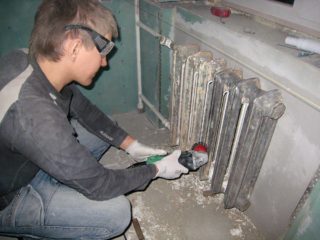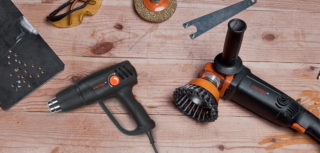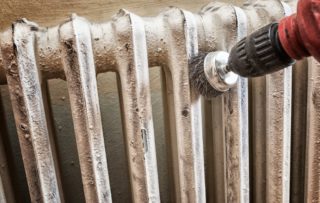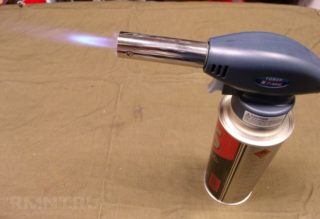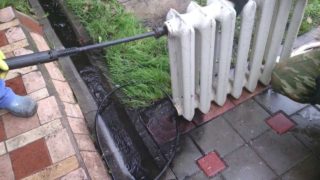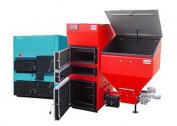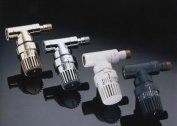The repair process often requires repainting of the old radiators of the heating system in the bathroom, in the kitchen or in the living room. The old coating often cracks, becomes cloudy, and traces of indelible dirt may appear on it. Processing allows to give structures a new look, saving on replacement. The first step is to remove the previous coverage. Before you remove the old paint from the radiators, you need to prepare the surface and decide on the cleaning method. There are several methods, the choice is made taking into account the area, inaccessibility, budget and other factors.
Features of the work and the choice of paint
During the painting of radiators, the removal of the old coating, surface preparation and subsequent application of a new layer are carried out. For processing, the following paint and varnish compositions are more often used:
- Based on acrylic. Such paints do not have a pungent odor, are easy to apply, and retain brightness for a long time. To obtain the desired shade, pigment is added to the base.
- Alkyd paints. The finished coating is more durable, but can turn yellow if the batteries are painted white or light.
- Based on heat-resistant varnish. Such paints are relatively inexpensive, resistant to strong temperature extremes.
- Silicone compounds. They are covered by the radiators themselves and the metal heating pipes.
Acrylic compounds withstand a maximum temperature of +80 degrees Celsius.
Tools and tools for washing paint
Before removing paint from the heating battery, you need to purchase the following devices:
- putty knife;
- wire brush;
- rags;
- latex gloves;
- protective glasses;
- respirator.
If you have to clean off the coating using chemistry, you will need to buy a solvent. A primer, new paint is also needed.
Preparation for cleaning
Before you clean the battery from old paint, you need to carry out preparatory work. The heating is turned off, the radiators themselves are removed, allowed to cool: it is dangerous to handle a hot product, especially if it is necessary to remove the coating by chemical means. Dirt is washed off the surface: it will interfere with effective cleaning.
It is especially important to treat hard-to-reach places where a large amount of dust accumulates. The floor in the room must be covered with a film so that the remnants of the old coating or new paintwork do not stain the surface.
Methods for removing old paint
There are three main methods for removing the old coat of paint and varnish from a radiator.
Mechanical
The most time-consuming solution is manual cleaning of the product: this takes more time and effort. More often this method is used to process cast iron batteries. To remove old paint use an electric drill with a rigid nozzle or a grinder. The surface is cleaned with an electric tool, then small areas are processed manually. To do this, use sandpaper with a coarse-grained structure, a spatula or a sponge made of metal.
Also, the mechanical method is used to remove paint in hard-to-reach places, for example, inside the radiator itself. To do this, take a wooden rail, wrap it with sandpaper. The finished product passes between the edges of the battery, allowing you to handle bottlenecks.You can clean the structure with a spatula, it makes it possible to remove traces of paint at the joints and corner parts.
Thermal
To remove in this way, the following devices will be required:
- building hair dryer;
- fine mesh metal mesh;
- set of spatulas;
- sponge or rag.
During thermal cleaning, the basic condition is required: to dismantle the battery and carry out processing on the street. But if the pipes are stationary or the owner does not have the opportunity to remove the radiator, you can do with wall protection using thick sheets of cardboard.
The process of removing old paint by the thermal method involves the following steps:
- The old coating is heated. If there is no building hair dryer, use a soldering iron. When the paint begins to peel, further processing can be carried out.
- The exfoliated substance is removed with a spatula. It is necessary to clean the battery while it is hot, as the composition hardens again as it cools.
- Heatsink heating is done in parts, first they treat large surfaces, then small and hard-to-reach areas.
- As the product cools, it is prepared for re-painting. To do this, the surfaces are wiped off from the residual substance with a rag, then they are cleaned, degreased, covered with a primer.
- Apply fresh paintwork. As it completely dries, the structure is mounted back.
Thermal cleaning is characterized by increased efficiency and safety, but not everyone has the appropriate equipment. To save money, it makes sense to rent it, and not buy it.
Chemical
This is the fastest option, but the process requires strict adherence to security measures. Before cleaning the product using chemistry, a set of preparatory steps should be taken:
- washing, drying the battery;
- airing the room;
- purchase of a respirator, goggles and gloves.
Solvents used during processing are aggressive chemicals, they can greatly damage the skin and mucous membranes if they come in contact with them.
To remove the old paint layer chemically, you need to do the following:
- The solvent is poured into the prepared container. 50-100 ml of substance are required.
- With a construction brush, the liquid is applied to the heating radiator. The inner surface should be especially carefully coated. For the treatment of hard-to-reach areas, small brushes with curved handles are used.
- It takes some time to soften the coating. Readiness is indicated by the appearance of flakes and peeling paint.
- They clean the radiator with a spatula with an average size of the working element. The internal parts and ribs are cleaned with a narrow spatula.
- Finishing with a brush or sponge with a metallic pile.
The surface is treated with a primer. This allows you to improve adhesion and prepare the product for a new application of paint.
Basic security measures
During processing it is important to observe the following requirements:
- use protective clothing and equipment, it is especially important to use it when processing chemicals that can cause allergies, burns, damage to mucous membranes and skin;
- chemical and thermal treatment is required to be carried out outdoors or to ensure high-quality ventilation of the room, it is desirable to use a forced ventilation scheme;
- protect furniture, interiors, appliances and electronics from paint, solvents and other hazardous substances;
- Protect children and pets while handling batteries.
Removing paint from heating radiators is a relatively simple procedure, which can be managed independently. The simplest is the mechanical method, however, it is more time-consuming and requires more time.The chemical method is more dangerous, but provides the fastest possible removal of the substance, and the thermal option is good for processing a large number of batteries.
